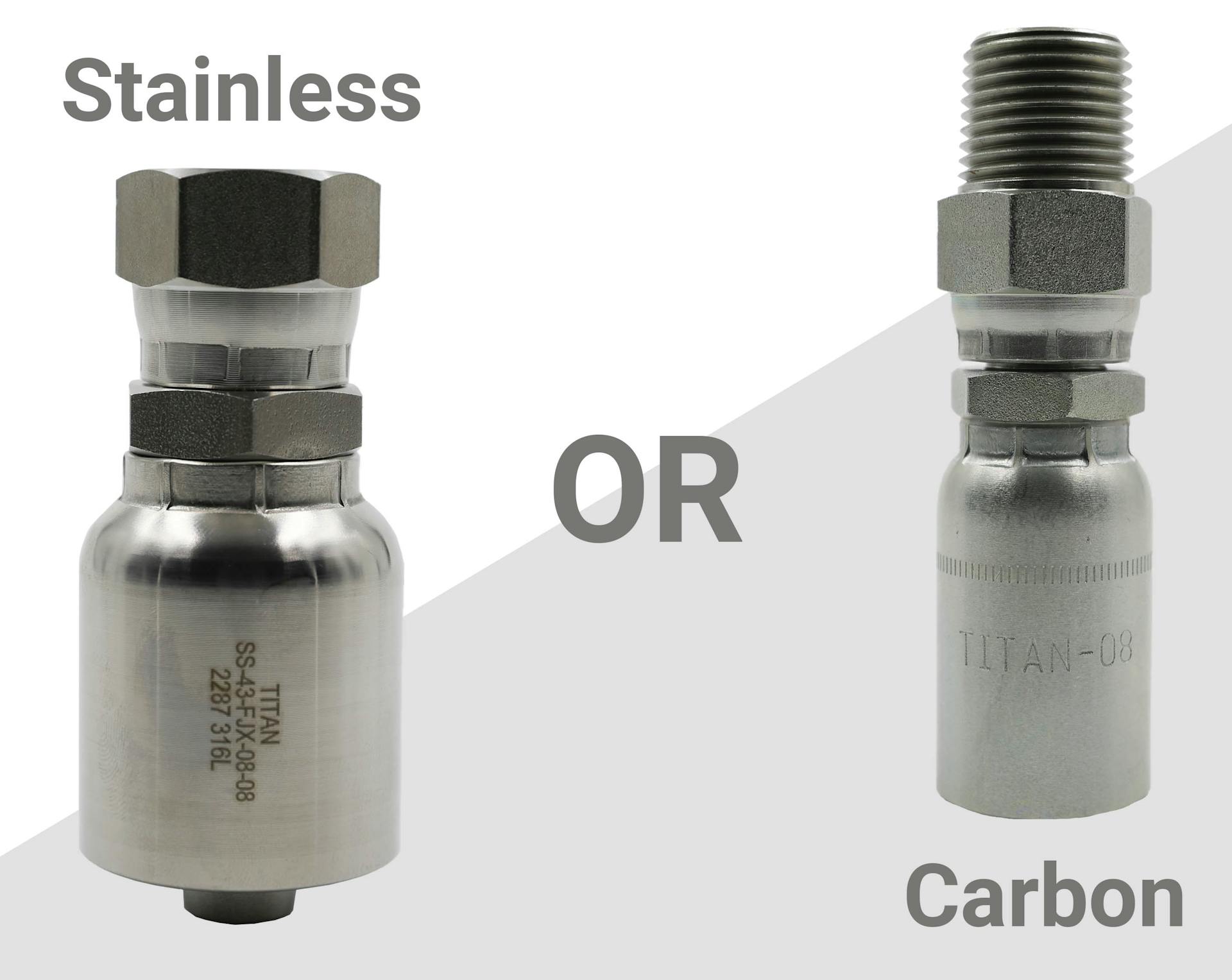Image Description: An image showing different hydraulic hose end fittings
Perhaps no material has held more importance in our history than steel. Since the last century, advancements in steel manufacturing have brought about rapid industrial growth and innovation in multiple sectors. Similarly, hose end fittings made from steel have allowed hose assemblies to be manufactured as per specifications.
Although materials like brass and aluminum can also be used for hose end fittings, variants of steel are most commonly seen in hose assemblies for hydraulic systems. Which one is selected greatly depends on the physical conditions hose assemblies have to endure. Alternatively, availability and curtailing costs are factors one needs to consider before selecting the correct fitting. It requires sound knowledge to judge which fitting material is best for a particular hose assembly. Here's some essential information regarding different steel variants that can help make your decision easier.
Carbon Steel
Carbon Steel Composition
As its name implies, carbon is the main component in this type of steel other than iron. However, by mass, it's not a lot, but even small percentage changes in the quantity of carbon can lead to varying grades of steel manufactured. Some trace elements, like manganese, nickel, and molybdenum, are also added to improve additional properties.
Carbon Steel Fittings Uses:
Hose end fittings need to withstand intense pressure surges and must remain durable when operating under harsh working environments. Hence, using high carbon steel for manufacturing hose end fittings may not be the most suitable choice. A higher carbon content makes steel harder; however, it makes it more brittle as well. Brittleness causes steel to crack or break when intense forces are exerted upon it, making it unsuitable for use on hose assemblies where crimping is required.
Low to mild steel is a better alternative for hose end fittings as it is easier to manufacture and work with. There is one drawback, though. It is not durable in harsh environments and may rust easily without protective coatings. This is where stainless steel comes in.
Stainless Steel
Stainless Steel Composition:
Iron, carbon, chromium, and nickel are the three major components of stainless steel. Steel needs to have greater than 10.5% chromium by mass to classify as stainless steel. The chromium in the final product interacts with oxygen in the air to form a protective layer on the steels' surface, making it corrosion resistant.
Like carbon steel, stainless steel also has a range of chemical compositions that determine its properties. The 304 and 316 series are the most commonly used because of their high strength and corrosion resistance properties.
Which One Should You Use for Hose End Fittings?
Although it can be hard to discern which steel type is best for hose end fittings, it largely depends on the application and the surroundings of a hose assembly. In cases where you are likely to encounter high corrosion, like chemical plants and marine or offshore environments, one might have to opt for hose end fittings made from stainless steel. If the longevity of components is not an issue, then carbon steel will satisfy your needs.
Additionally, you can calculate the cost-benefit analysis of selecting a particular hose end fitting, including estimates for cost, expected life of the product, and additional maintenance costs required during its lifetime.
Advantages of Using Stainless Steel Over Carbon Steel Fittings
Hydraulic hose end fittings made from stainless steel are a better option compared to carbon steel fittings given the benefits they offer:
Weight:
You'll find variants of fittings that come in both types of steel; however, there's a stark difference in their sizes. For the same specifications, stainless steel fittings have thinner walls compared to carbon steel fittings, reducing weight and dimensions for the overall assembly.
Temperature:
Stainless steel fittings are better at resisting temperature and the subsequent stresses because of it. This means that they can provide excellent performance at wider temperature ranges and don't exhibit structural deformation due to temperature changes, increasing their durability.
Cost:
Although stainless steel fittings are more expensive than carbon steel fittings, their running costs are significantly lower than carbon steel fittings. They don't require layers of protective coating to prevent corrosion, making them easy to maintain in the long run. Moreover, they retain their resale value and can earn you a hefty profit when you choose to recycle them.
All of the above features make them suitable for a wide range of applications, especially those that require a high degree of strength. Stainless steel fittings are almost exclusively used in the food and beverage industry on account of the industry's sanitation requirements. Carbon steel can corrode and introduce impurities into a system, whereas stainless steel is chemically compatible with many materials and does not affect the chemical properties of the substance it carries.
Shop Adapters and Fittings
